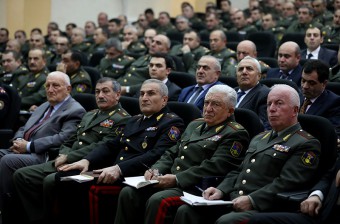…
29 October, 2016 15:23Greeting the participants and presenting the agenda of the meeting, Minister of Defense of the Republic of Armenia Vigen Sargsyan spoke about the implementation of the "Nation-Army" philosophy and the main strategies to achieve the maximum results. The head of the defense administration highlighted the fact that the concept of the "Nation-Army" goes far beyond that of the national army, and does not imply the militarization of society or state. "Society cannot be isolated from the army, and visa versa. Democratization of the army and its complete integration into society, economy, culture, education, science and sports serves the purpose of turning us into one unit, strengthening the combat readiness of our Armed Forces through accomplishments in civilian sectors. The nation-army is that which has the potential to educate, cultivate and train, and passes this potential to the people. The nation-army is that society and armed forces, where there only one step exists between innovative technologies and the military-industrial complex, it is that trust, which society holds for the Armed Forces, and our nation's officers. It is that defense system, where each individual is prepared for mobilization, knows his responsibility, role and the resources available to him," noted Minister of Defense Vigen Sargsyan.
The main reports were made by Chief of the Operative Department of the General Staff of the Armed Forces of the Republic of Armenia, major-general Artak Davtyan and Chief of the Department of Combat Readiness of the Armed Forces of the Republic of Armenia, major-general Tiran Khachatryan. In other reports, speeches and the question-answer dialogue that followed, it was emphasized that significant works have been carried out, aimed at enhancing planning and organization of professional and command preparation of the operational link of the Armed Forces. Special attention was paid to events dedicated to studying and exchanging best practices. The level of harmonization between headquarters and of the knowledge, abilities and skills of officers have risen significantly. New methods and ways of teaching have been widely implemented. Military exercises, command and strategic camps, training sessions for exhibition or practice, group exercises, target practice and a variety of other exercises were organized.
Relevant assignments were given to the participants, based on the active discussions held beforehand.
 Հայերեն
Հայերեն English
English Русский
Русский


























